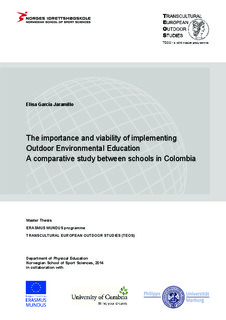| dc.description.abstract | Environmental Education (EE) is a relatively new field which was internationally recognized in 1977. Moreover, it has been described as a multidisciplinary subject because it encompasses elements of diverse areas of study such as: ecology, economy, politics and philosophy. Its lack of trajectory as well as the complexity of its nature makes it a harder subject to approach, particularly in conventional school settings. Increased environmental concern has helped raise the question of how to address EE. Consequently, significant research has focused on EE pedagogy and several studies have shown that incorporating the outdoors in its practice can generate better outcomes. Therefore, the purpose of this research is to explore the viability of implementing Outdoor Environmental Education (OEE) in private schools in Manizales, Colombia and to promote its importance and implementation. Considering the context and conditions of most schools in the city is key; groups have large numbers of students, resources are scarce and installations do not offer many possibilities. In this paper, I will present a hypothesis that limited accessibility to nature may be a determining factor that prevents teachers from implementing OEE in their classes. With this in mind, this research will compare the ways in which EE is taught at schools that have immediate access to nature -green schools-, and at schools that do not -regular schools-. This can help explore the implications of having accessibility to nature, and answer the following research questions: 1) What are the main differences between EE classes taught at regular and green schools? 2) How do teachers perceive and incorporate the outdoors in their classes? And 3) What challenges do teachers face when it comes to implementing OEE? Current literature on EE and OEE was consulted. A brief historical perspective of the subject is provided, as well as information on current trends and the Colombian context. Given the characteristics of the research questions, a qualitative oriented methodology was implemented to address them. The researcher visited four urban private schools in the city and three teachers from each school were interviewed. The data generated was analyzed through thematic coding and decoding, and through the hermeneutic approach. As expected, it was found that accessibility to nature does play a decisive role in the implementation of OEE, and on the way teachers’ perceive the outdoors. However other factors such as teachers’ motivation, planning, time and resources are also important. Furthermore, it was found that EE is not available to all students as only few get to actively engage in relevant activities and practices. Therefore the main conclusion of the project is that, despite what the Ministry of Education states, in practice, EE is still an under prioritized subject, and it is not given the emphasis it requires in formal schooling environments. This, in consequence, also represents the main hindrance for the implementation of OEE. | nb_NO |
